
The 7th London Chess Classic, England's premier tournament, took place at its traditional venue of Kensington Olympia from Friday December 4th to Sunday December 13th. The main event, the strongest ever held in the UK, was a nine-round ten-player super tournament played at a rate of 40 moves in two hours, followed by the rest of the game in one hour, with a 30-second increment from move 41. The overall prize fund was $300,000, with the winner getting $75,000.
A Magnuficent Sunday at LCC 2015 – Part two
Report from London by Sagar Shah and Amruta Mokal
This was the standing aftr nine rounds of the 2015 London Chess Classic:
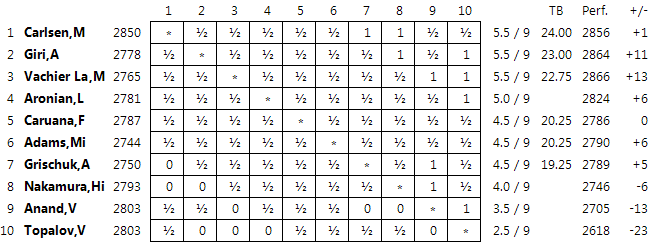
The rules of the event meant that there had to be a playoff between the top three players. Reporters, photographers, chess fans and most of all the players, Anish and Maxime, had only thirty minutes to get ready for the tiebreak match. Just when everyone decided to grab a quick bite or refresh themselves with a tea or coffee, a very important guest made an appearance at the tournament venue. Hoards and hoards of people gathered around him as Jennifer Shahade did an interview for the online viewers. Can you guess who he was?
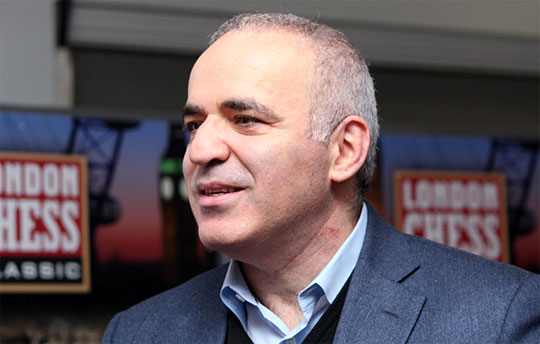
Of course, none other than the mastermind behind the Grand Chess Tour,
the thirteenth World Champion Garry Kasparov
Garry spoke on various topics, including the Grand Chess Tour, the rapid tiebreak playoffs, Kirsan Illyumzhinov and plans for the next year’s GCT. One of the important points he proposed was to have the final tiebreak on the next day – the winner of Giri and Vachier-Lagrave should take on Magnus on the 14th of December and not immediately, as that would give them enough time to recuperate and regain their energy. However, technically this was not feasible and the winner had to be decided that night, no matter how long the games went on!
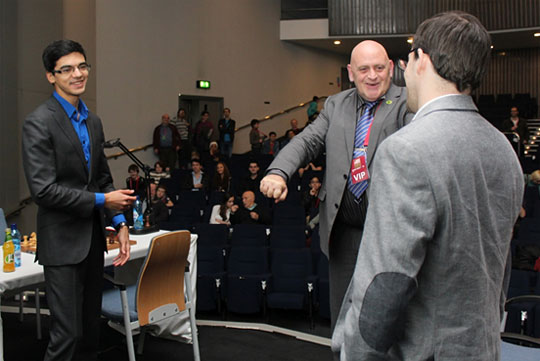
Arbiter Albert Vasse made Maxime choose the colour for the first game, and the Frenchman
got the white pieces. When the arbiter asked Anish if he was fine with that,
the 21-year-old replied with his typical sense of humour – “No!”

The tiebreaks had begun and the spectators were in for a treat
The Berlin Wall is considered as a super solid opening, often extremely drawish in nature. In the first game of this rapid match Anish proved how it could actually be a dangerous weapon if White plays too naively. MVL exchanged a lot of pieces and by the 20th move had an extremely unpleasant position. Anish played the next phase of the game to perfection, winning a pawn and then converting his advantage with consummate ease. The Dutch GM was 1-0 up in this two-game match.

[Event "7th London Classic TB"] [Site "London ENG"] [Date "2015.12.13"] [Round "1.1"] [White "Vachier-Lagrave, Maxime"] [Black "Giri, Anish"] [Result "0-1"] [ECO "C67"] [WhiteElo "2773"] [BlackElo "2784"] [Annotator "Sagar Shah"] [PlyCount "86"] [EventDate "2015.12.13"] 1. e4 e5 2. Nf3 Nc6 3. Bb5 Nf6 4. O-O Nxe4 5. d4 Nd6 6. Bxc6 dxc6 7. dxe5 Nf5 8. Qxd8+ Kxd8 {Of course Anish puts his money on the Berlin to defend from the black side of game one of the rapid tiebreaks.} 9. h3 Ke8 10. Nc3 h5 {Maxime sank into thought here trying to remember the best setup that would suit him in this shortened time control.} 11. Ne2 b6 12. Rd1 Be7 13. Bg5 Bb7 14. Bxe7 Kxe7 15. Ned4 Nxd4 16. Nxd4 {White tries to play in an extremely simplified fashion. But the funny thing about Berlin is that once you try to play very normal moves Black has his trumps and he tends to come out on top. Like in this case.} c5 $1 (16... g6 {Trying to stop Nf5 won't be the most accurate.} 17. f4 c5 18. Nb5 Rhc8 19. Kf2 {and White is basically a tempo up as compared to the game.}) 17. Nb5 (17. Nf5+ $6 Ke6 18. Nxg7+ Kxe5 $19 {and the knight is trapped in the corner.}) 17... Rhc8 $1 {a6 or Bc6 is coming up next, and the knight will be kicked out.} 18. f4 Bc6 (18... a6 {was also pretty good.} 19. Nc3 Rd8 $15) 19. Nc3 Ke6 20. Kf2 h4 $1 {Let us try to understand the reasons why Black is better here. His king is centralized, the pawn on g2 is fixed. Also the bishop on c6 somehow dominates the knight on c3. Because of all these reasons Black is just better.} 21. a4 Kf5 22. Ke3 (22. Nd5 $1 {It was necessary to make this move if he wanted to have any chances of equalizing.} Bxd5 23. Rxd5 Kxf4 24. Rd7 $1 Kxe5 25. Rxf7 Rf8 26. Re1+ Kd6 27. Ree7 Rxf7+ 28. Rxf7 g5 $11 {Black should be very slightly better, but a draw would be the most likely outcome.}) 22... Re8 $1 {A very nice move. Now Nd5 will be met with Rac8 and Nb5 with Re7. Besides f6 is threatened.} 23. Nd5 Rac8 $1 24. Rd2 f6 {Giri's play is a model game for anyone who would like to know the reasons why Berlin should be played.} 25. Rf1 fxe5 26. fxe5+ Kg5 $1 (26... Kxe5 { was also possible.}) 27. Nc3 Rxe5+ {Black wins a pawn and the rest should be just a matter of technique.} 28. Kf2 Rf8+ 29. Kg1 Rxf1+ 30. Kxf1 Rf5+ 31. Kg1 Rf4 32. Re2 Kf6 33. b3 a6 34. Nd1 Bd5 35. c4 Be6 36. a5 Rd4 37. Nf2 Bf5 38. Ra2 Rd6 39. Kf1 (39. axb6 Rxb6 $19 {[%cal Gb6b3]}) 39... Ke5 40. Re2+ Kf4 41. Ra2 g5 42. Ke1 Re6+ 43. Kf1 Re3 (43... Re3 {Maxime resigned when he realised that he would soon lose all his pawns. The onus was now on the Frenchman to win with the black pieces.} 44. axb6 cxb6 45. Rxa6 Rxb3 46. Ra2 Rc3 47. Rb2 Rc1+ 48. Ke2 Rxc4 49. Rxb6 Kg3 $19) 0-1
Before the tiebreaks began I had asked MVL what is the most important quality that a chess player must have in order to become a world class GM? Without much hesitation the 25-year-old French grandmaster replied: “self-confidence.” A point down against the super solid Giri and a must-win situation with black is something that would discourage many a strong players, but not Maxime. He did not lose faith in his abilities and in an equal endgame kept posing minute problems to his opponent. The time was ticking down and Anish started to show nerves. Things went out of control, and in a drawn position Giri blundered a piece and the match was equalized.

[Event "7th London Classic TB"] [Site "London ENG"] [Date "2015.12.13"] [Round "1.2"] [White "Giri, Anish"] [Black "Vachier-Lagrave, Maxime"] [Result "0-1"] [ECO "D85"] [WhiteElo "2784"] [BlackElo "2773"] [Annotator "Sagar Shah"] [PlyCount "118"] [EventDate "2015.12.13"] {After scoring a win with the black pieces, Anish finds himself in an enviable situation of holding Maxime with white. Knowing the solid player that he is, it shoudn't be a very tough task.} 1. d4 Nf6 2. c4 g6 3. Nc3 d5 4. cxd5 Nxd5 5. g3 Bg7 6. Bg2 Nb6 (6... Nxc3 7. bxc3 c5 {is much more common, but White can be solid here with} 8. e3) 7. Nf3 Nc6 8. e3 O-O 9. O-O Re8 10. b3 e5 11. Nxe5 Nxe5 12. dxe5 Bxe5 13. Bb2 Qe7 14. Qc2 c6 15. Rad1 Bg4 16. f3 Be6 17. f4 Bg7 18. e4 Rad8 19. e5 Bg4 20. Bf3 (20. Rxd8 Rxd8 21. Ne4 $14 {might have been better way to continue.}) 20... Rxd1 21. Qxd1 Rd8 22. Qe2 Bxf3 23. Rxf3 f6 24. exf6 Qxe2 25. Nxe2 Bf8 (25... Rd2 26. fxg7 Rxb2 27. Nc3 Kxg7 $11) 26. Bd4 Kf7 27. Rc3 Nd5 28. Rc4 Nxf6 {Black has recovered the pawn and the position is about equal. But Maxime needs to win and hence tries to keep as many pieces on the board as possible.} 29. Kg2 Nd5 30. Kf3 a5 31. Bc5 Bg7 32. Bd4 Bf8 33. Bc5 Bh6 {At this point it seemed as if Giri was quite confident that he would easily make a draw. But now he starts making mistakes and soon lands up in a positional that pretty irritating to defend.} 34. Rd4 Bg7 35. Rd2 a4 $1 36. Bd4 (36. b4 { might have made it easier to achieve the draw.}) 36... Bxd4 37. Rxd4 axb3 38. axb3 Ra8 $1 {The rook takes the open file and is threatening to penetrate to a2. It is not much but it is surely quite unpleasant.} 39. Rd3 Ra2 40. h3 Rb2 41. Nd4 h5 42. f5 $1 {A good move by Anish. It either exchanges a few more pawns or secures the e6 square for the knight.} g5 43. Ne6 Kf6 44. Nd8 (44. g4 {would have been good, but it is very difficult for a human to make this move, especially when your opponent can play h4.} h4 45. Nc5 Rh2 (45... Nf4 46. Ne4+ Ke5 47. Nc5 $1 Kf6 48. Ne4+ $11) 46. Ne4+ Kg7 47. Nxg5 Kh6 48. Nf7+ Kg7 49. Ng5 $11) 44... Rh2 $1 {A super accurate move by MVL.} 45. Nxb7 Rxh3 (45... h4 $6 46. Kg4 hxg3 47. Kxg3 $11) 46. Nd6 Rh2 47. Ke4 Re2+ 48. Kd4 Ne7 49. Kc5 $6 (49. g4 $1 {was such a nice move but so difficult to find in time pressure.} hxg4 50. Ne4+ Kf7 51. Nxg5+ $11) 49... g4 50. Kb6 Re5 51. Kc7 c5 $6 (51... Nd5+ $1 $19) 52. Nc4 Rxf5 53. Rd6+ Kg5 54. Re6 Nd5+ 55. Kd6 h4 56. gxh4+ Kxh4 57. Ne5 $6 (57. Re5 {would have ensured a draw now as after} Rxe5 58. Nxe5 Nf4 59. Nxg4 Kxg4 60. Kxc5 $11) 57... Nf4 58. Rh6+ Kg5 59. Rh8 $2 (59. Rh7 {would have preserved excellent drawing chances.}) 59... Rxe5 $1 {As alert as ever, MVL grabbed his chance and equalised his match forcing the games into a tiebreak.} 0-1
The ChessBase cloud function Let's Check shows us instantaneosly the chances Giri missed:


49.g4! was a nice move but difficult to find in time pressure. After 49.Kc5?! White is in trouble.
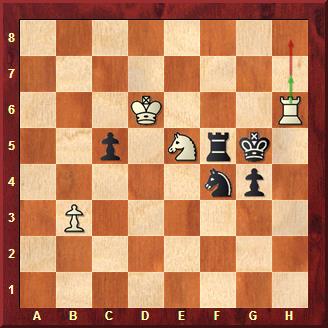

59.Rh7 would have preserved excellent drawing chances, but after 59.Rh8? White was lost
It was all even at 1-1 and time for the Armageddon. Maxime won the toss and chose the black pieces. This meant that he had five minutes, Anish got six, (three second increment after move 61) but a draw would mean that MVL would advance. Most of the top players prefer to have the draw odds, and choose black. The one minute advantage is not too much. After winning with black in game one and having a completely drawn position in game two, the situation had turned 180 degrees for Giri in a matter of minutes.

“Go for something unusual”, Tukmakov advises his protégé
In the end the blitz game was a pretty one-sided affair where MVL easily equalized and then snatched the initiative. At no point did Giri have the chance to play for a win. In the end Anish overstretched and had to resign.

[Event "7th London Classic TB"] [Site "London ENG"] [Date "2015.12.13"] [Round "1.3"] [White "Giri, Anish"] [Black "Vachier-Lagrave, Maxime"] [Result "0-1"] [ECO "A05"] [WhiteElo "2784"] [BlackElo "2773"] [Annotator "Sagar Shah"] [PlyCount "82"] [EventDate "2015.12.13"] {Maxime won the toss and decided to choose the black pieces, which meant that he had five minutes to Anish's six. But the Frenchman had draw odds.} 1. Nf3 Nf6 2. g3 g6 3. b3 Bg7 4. Bb2 b6 5. Bg2 Bb7 6. O-O O-O 7. c4 c5 {All symmetrical until now. But the players slowly start to break the symmetry.} 8. e3 d6 9. Qe2 Nbd7 10. Rd1 e6 11. Nc3 Qe7 12. d4 Rad8 13. Qc2 (13. e4 $1 $14 { would have given just the kind of slight edge position that he would have been looking for in this game.}) 13... d5 14. Ne5 cxd4 15. exd4 Nxe5 16. dxe5 Ng4 17. cxd5 exd5 18. Bxd5 (18. Nxd5 Bxd5 19. Rxd5 Rxd5 20. Bxd5 Bxe5 21. Rd1 { would have led to a small edge for White.}) 18... Nxe5 19. Qe4 Bc8 $1 20. Re1 Bf5 $17 21. Qe3 Qc5 22. Rad1 Bg4 (22... Nd3 23. Rxd3 Bxd3 24. Qxd3 Bxc3 $19 { was equally good.}) 23. Rb1 Bf5 (23... Rxd5 $1 24. Nxd5 Nf3+ 25. Kg2 Qxd5 $19) 24. Be4 Nd3 25. Qxc5 bxc5 26. Bxd3 Rxd3 27. Na4 Rd2 28. Bxg7 Kxg7 {White has averted the worst possible outcome, but Black is still completely fine and for White to win this game is a next to impossible task.} 29. Rb2 Rfd8 30. Re2 Rd1+ 31. Kg2 c4 32. bxc4 Bd3 33. Re7 Bxc4 34. Re3 R8d6 35. a3 Bf1+ 36. Kf3 Rf6+ 37. Ke4 Re6+ (37... Bg2+ 38. f3 Bxf3+ 39. Rxf3 Re6+ 40. Kf4 Rd4+ 41. Kg5 h6#) 38. Kf3 Rf6+ 39. Ke4 Re6+ 40. Kf3 Rf6+ 41. Kg4 Rd4+ {[%cal Gd4a4] The knight is lost and Giri had to resign.} 0-1

Expletive deleted: the moment when Anish gave up and Maxime advanced to the finals
A pretty sad result for Anish, who otherwise had a wonderful tournament, gaining ten Elo points and climbing to a live rating of 2794 and world number three spot! But this is not the last event of the year for the Dutch grandmaster as he gets ready to participate in the Qatar Masters Open beginning from 20th of December.
Maxime Vachier-Lagrave vs the World Champion
Maxime Vachier-Lagrave had thirty minutes to recover before he faced the World Champion to determine the winner of the London Chess Classic 2015. There was much more at stake. If Maxime lost the match then he would have to settle for the third position in the tournament. This was surprising because he had already beaten Giri. But the rules clearly mentioned that the playoff will only decide the winner, all other spots would be resolved by the tiebreak rules as laid down prior to the event, like number of wins, personal encounter, Sonneborn-Berger, etc. Things would get trickier if MVL won the tiebreaks. He would then receive 12 points in the Grand Chess Tour, which would be added to his prior tally of 12 points. This would make it a total of 24. Magnus would then get 10 Grand Chess Tour points (as he would finish second) and adding it to his previous 14 points also gives 24! It meant that if Maxime won the playoff he would win the London Chess Classic, but the Grand Chess Tour points would be tied and another tiebreak would be required on Monday between the two players to determine the winner! Amidst all this confusion and calculations the first game of the rapid match began.
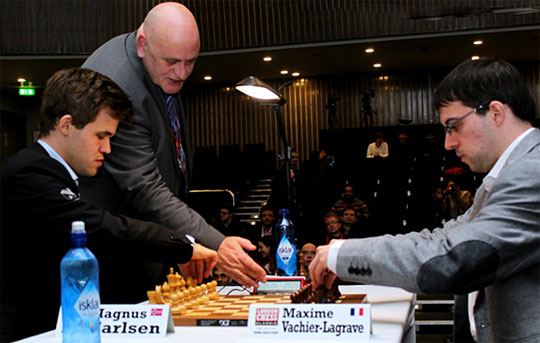
Magnus had the white pieces and was clearly the player with the higher energy level
After getting a typical small edge from the opening it seemed as if Carlsen would win the game without much ado. However, Maxime’s strategy of playing fast and not losing time on the clock began to bear fruit. Carlsen got a little nervous and botched up a major chunk of his advantage. Finally it all boiled down to a theoretical rook endgame where the French GM had to find a study like idea to save the draw. He wasn’t able to do so and the World Champion took the lead.

[Event "7th London Classic TB"] [Site "London ENG"] [Date "2015.12.13"] [Round "2.1"] [White "Carlsen, Magnus"] [Black "Vachier-Lagrave, Maxime"] [Result "1-0"] [ECO "B52"] [WhiteElo "2834"] [BlackElo "2773"] [Annotator "Sagar Shah"] [PlyCount "113"] [EventDate "2015.12.13"] 1. e4 c5 2. Nf3 d6 3. Bb5+ {After having played the same line successfully against Grischuk in the classical game earlier in the day, Magnus does not flinch from giving it another go.} Bd7 4. Bxd7+ Qxd7 5. c4 Nf6 6. Nc3 g6 7. d4 cxd4 8. Nxd4 Bg7 9. f3 (9. O-O O-O 10. f3 Rc8 11. b3 d5 $1 $11 {is known to be an equalising idea since a long time. Hence f3 is more accurate than 0-0.}) 9... O-O 10. Be3 Nc6 11. Rc1 Nxd4 12. Bxd4 Rfc8 13. b3 {This is a position with a small but stable edge for White.} Nh5 $5 14. O-O Bxd4+ 15. Qxd4 Nf6 16. Rfe1 $1 {Magnus brings his rooks to the central files.} Rc7 17. Rcd1 Qc6 18. Nb5 (18. Nd5 Nxd5 19. exd5 $14 Qc5 20. Qxc5 dxc5 21. Rd2 {is also a pleasant position, but maybe Black can defend, as e7 is the only weakness right now.}) 18... Rd7 19. Nxa7 Qc5 20. Qxc5 dxc5 21. Nb5 Rxa2 22. e5 Rxd1 23. Rxd1 Nh5 24. g3 Rb2 25. Rd8+ Kg7 26. Re8 Rb1+ (26... Rxb3 27. Rxe7 Rxf3 28. Nd6 $16 { Black's biggest problem is his knight on h5.}) 27. Kg2 Rb2+ 28. Kg1 Rb1+ 29. Kg2 Rb2+ 30. Kh3 e6 31. Re7 Rxb3 32. Kg4 (32. Nd6 Rxf3 33. Kg2 Rc3 34. Rxf7+ Kg8 35. Rxb7 $16 {was a better way to gain an edge.}) 32... Kf8 33. Rxb7 h6 34. Rc7 f5+ 35. exf6 Nxf6+ 36. Kf4 g5+ 37. Ke5 Ne8 38. Rxc5 Re3+ 39. Kd4 Rxf3 { Maxime was playing with great speed and already had a big time advantage. Now his position was also pretty much defensible.} 40. Re5 Rf2 41. Rxe6 Rxh2 42. c5 h5 43. Nd6 $6 (43. Nc3 $14) 43... Nxd6 44. cxd6 Kf7 45. Re3 {Carlsen,M (2834) -Vachier-Lagrave,M (2773) London 2015} h4 46. g4 h3 47. Ke5 Rh1 48. d7 Ke7 49. Kf5+ Kxd7 50. Kxg5 {[#]It seems as if White is completely winning here because he just keeps an eye on the pawn with the rook. For eg. h2 is met with Re2, the black king is cut off and the white king moves to the h-file and starts pushing the g-pawn down the board. However, there is a study-like solution for Black to draw the game.} Kd6 ({or} 50... h2 51. Re2 Kd6 $1 {Only move. Black has to wait till the white king goes to the h-file before leaving the h1 square with his rook.} 52. Kh5 (52. Kg6 Rg1 $11) 52... Rc1 $1 53. Rxh2 Rc8 $3 { The only way to make a draw. The threat of skewering the rook from h8 makes it impossible to push the pawn to g5 which would be a theoretical win.} 54. Re2 Rh8+ 55. Kg5 Rg8+ 56. Kh5 Rh8+ $11) 51. Kh5 Rf1 $2 (51... h2 $1 52. Re2 Rc1 53. Rxh2 Rc8 $1 {and just like in the previous variation Black makes a draw.}) 52. Rxh3 Ke7 53. Kg6 $1 {Shouldering!} Rf6+ 54. Kg7 Rf7+ 55. Kg6 Rf6+ 56. Kg5 Ra6 ( 56... Kf7 57. Rh7+ $18) 57. Rf3 {The basic Lucena position will be reached pretty soon and Black will have to resign. A very interesting game especially with a nice touch in the rook endgame.} 1-0

Going in to game two Henrik Carlsen and Peter Heine Nielsen ensure that nothing goes wrong
In the second game of the match Maxime chose the English Opening and tried to maintain as much tension as he could. The World Champion played with great care and very soon got a tangible advantage. In the rest of the game Vachier-Lagrave had absolutely no chance of creating any counterplay and had to agree to a three-fold repetition in a position which was most probably lost for him.

[Event "7th London Classic TB"] [Site "London ENG"] [Date "2015.12.13"] [Round "2.2"] [White "Vachier-Lagrave, Maxime"] [Black "Carlsen, Magnus"] [Result "1/2-1/2"] [ECO "A16"] [WhiteElo "2773"] [BlackElo "2834"] [Annotator "Sagar Shah"] [PlyCount "101"] [EventDate "2015.12.13"] 1. c4 Nf6 2. Nc3 c5 3. Nf3 e6 4. e4 Nc6 5. Be2 e5 6. d3 d6 7. a3 Be7 8. b4 b6 ( 8... cxb4 9. axb4 Nxb4 10. O-O O-O 11. Ba3 $44 {is good compensation for White. }) 9. O-O O-O 10. Rb1 Nd4 11. bxc5 bxc5 12. Bg5 Be6 13. Rb7 Nd7 14. Bxe7 Qxe7 15. Qa4 Nb6 $1 {A nicely calculated move.} 16. Qa6 (16. Rxe7 Nxa4 17. Nxa4 Nxe2+ $17) 16... Bc8 $1 17. Rxe7 Bxa6 18. Rb1 $6 (18. Nxd4 $1 exd4 19. Nd5 $11 {leads to equality.}) 18... Rfb8 (18... Nxe2+ 19. Nxe2 Rfc8 $17 {with the threat of Kf8 traps the e7 rook.}) 19. Kf1 Kf8 20. Rc7 Ne6 21. Rc6 Rd8 $6 ( 21... Ke7 22. Nd5+ Kd7 23. Rcxb6 (23. Nxb6+ Kxc6 $19) 23... axb6 24. Rxb6 Bb7 $19) 22. a4 Bb7 23. Rcxb6 axb6 24. Rxb6 {White has a pawn for the exchange, but the position is clearly in Black's favour. Look how carefully Carlsen circumvents all the possible traps and tactics and brings home the full point – okay, almost the full point, as he agreed to a draw in a clearly better position.} Bc8 25. Bd1 Ra6 26. Rb2 Bd7 27. g3 Bc6 28. Ke1 Rda8 29. Ra2 Rb6 30. Kd2 g6 31. Kc1 Nd4 32. Nd2 Rb4 33. Rb2 Rab8 34. Nb5 Rxb2 35. Kxb2 Ke7 36. Kc3 Bd7 37. f4 f6 38. Nf1 exf4 39. gxf4 Ne6 40. f5 gxf5 41. Ne3 Nf4 42. exf5 Bc6 43. d4 Be4 44. d5 Ng2 45. Nxg2 Bxg2 46. Bc2 Bf3 47. Kb3 Ra8 48. Nc7 Ra7 49. Nb5 Ra8 50. Nc7 Ra7 51. Nb5 {With this tiebreak win Magnus Carlsen became not only the London Chess Classic winner but also the Grand Chess Tour Champion.} 1/2-1/2
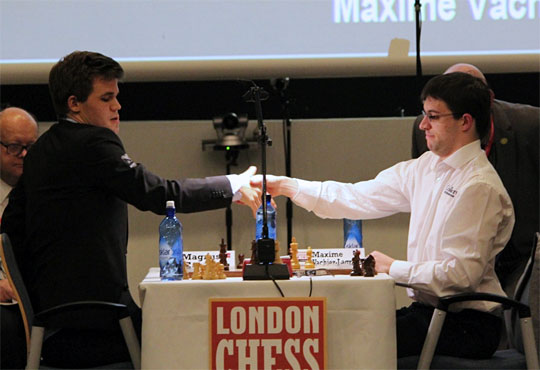
At 11.38 p.m. Maxime resigned and Magnus Carlsen became the London Chess Classic winner as well as the Grand Chess Tour champion. No pictures were allowed when the game was in progress. Our photographer waited with her camera and captured the exact moment of resignation.

Poor Maxime! He finished third at London and fourth in the GCT Standings.
The final tragedy: he didn’t qualify for the 2016 edition of the Grand Chess Tour.
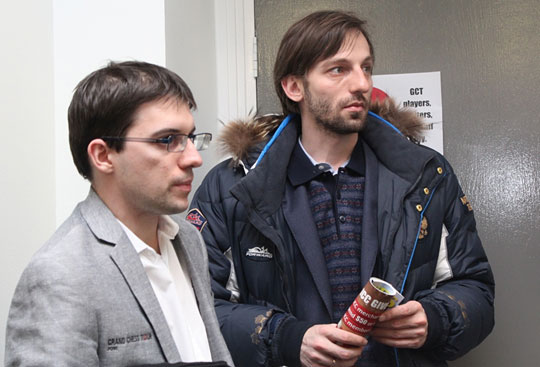
Alexander Grischuk stood by his friend’s side right to the bitter end

After all the drama and tension, nearing the stroke of midnight, Malcolm Pein presents
Magnus both the London Chess Classic and the Grand Chess Tour trophies.

The World Champion went back home richer by US $150,000.
Final standings of Grand Chess Tour 2015
|
Rank
|
Player |
Norway
|
Saint Louis
|
London
|
Total
|
|
1
|
Carlsen, Magnus |
4
|
10
|
12
|
26
|
|
2
|
Giri, Anish |
7
|
6
|
10
|
23
|
|
3
|
Aronian, Levon |
2
|
13
|
7
|
22
|
|
4
|
Vachier-Lagrave, Maxime |
5
|
7
|
8
|
20
|
|
5
|
Nakamura, Hikaru |
8
|
8
|
3
|
19
|
|
6
|
Topalov, Veselin |
13
|
4
|
1
|
18
|
|
7
|
Caruana, Fabiano |
6
|
3
|
6
|
15
|
|
8
|
Anand, Vishy |
10
|
2
|
2
|
14
|
|
9
|
Grischuk, Alexander |
3
|
5
|
4
|
12
|
|
10
|
Adams, Michael |
N/A
|
N/A
|
5
|
5
|
|
11
|
Hammer, Jon |
1
|
N/A
|
N/A
|
1
|
|
12
|
So, Wesley |
N/A
|
1
|
N/A
|
1
|
Photos by Amruta Mokal of ChessBase India










































